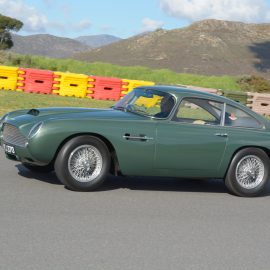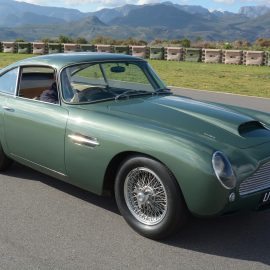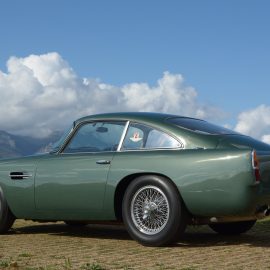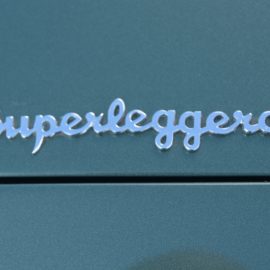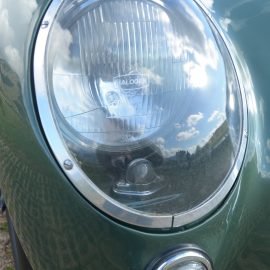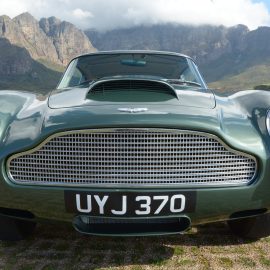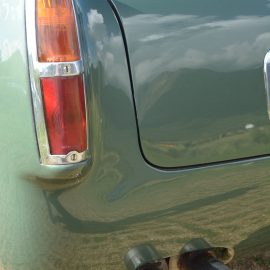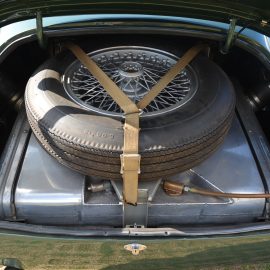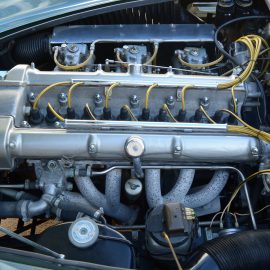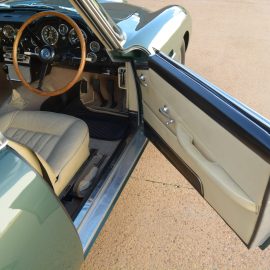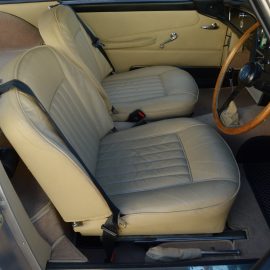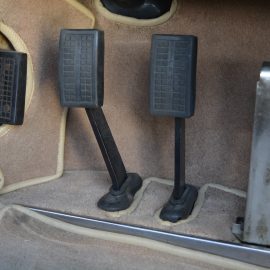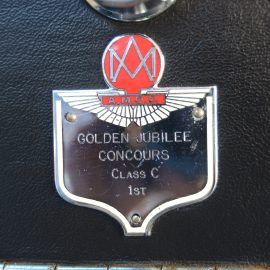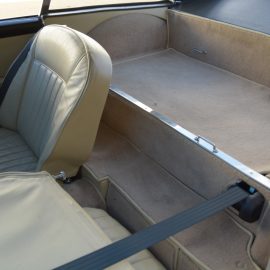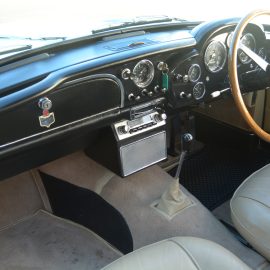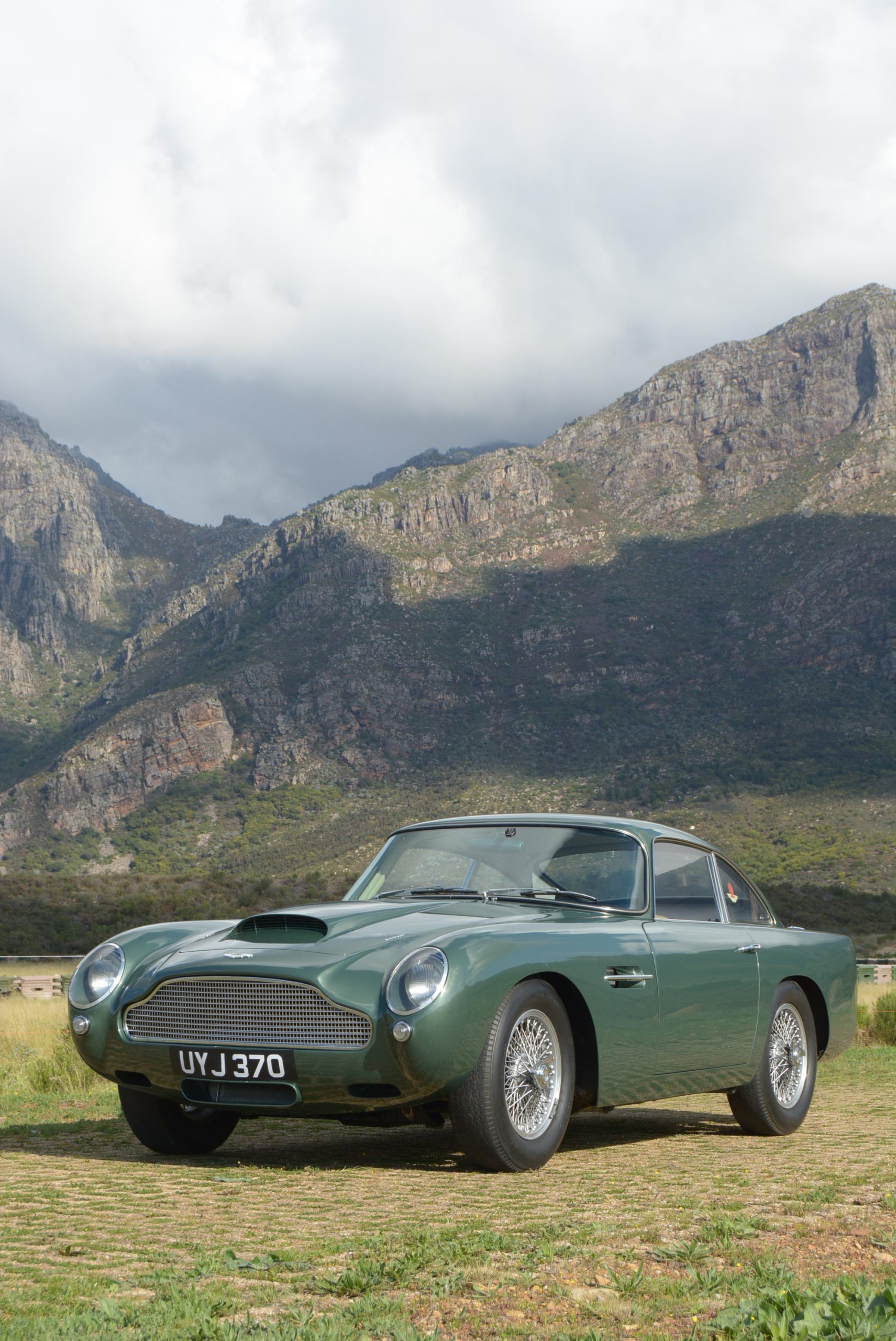
03 May Collection In Action: Aston Martin DB4 GT
‘The name’s Bond. James Bond.’ Well, not really. It’s Mike Monk, who adopts a double-oh persona agent and drives an Aston Martin that the world’s most famous secret service agent would surely have enjoyed…
If ever a brand had a hero then Aston Martin and James Bond epitomised the perfect partnership. It started in 1964 when Double-oh Seven used a DB5 as his personal transport in Goldfinger, the third of the Bond films, and it heralded an 11-movie relationship that lasted almost half a century. However, in the novel, author Ian Fleming had placed our secret service agent in a DB Mk.3, but as the DB5 had been launched in 1963 it was decided to use the newer car for the silver screen adaptation. What we have here is a special version of what came in between…
The DB Mk.3 was actually a DB 2/4 Mk.3 produced from 1957 to 1959, not to be confused with the DB3/DB3S sports racing car of 1951-56. The Mk.3 was, as the name suggests, the third variation of the DB2/4 that first appeared in 1953 and the facelift included the grille shape that was to become a trademark styling element for all future Aston Martins. The DB4, a special example of which is our featured car, appeared in 1958 to challenge Ferrari and was to stay in production until 1963, a fairly short life span during which there were five series upgrades, essentially an annual tweak to coincide with the UK’s Earls Court Motor Show.
Aston’s British engineer Harold Beach was responsible for the chassis development. Front suspension was by unequal-length double wishbones, coil springs and anti-roll bar, while the Mk.3’s De Dion rear axle was ditched in favour of a coil-sprung live rear axle located by twin radius arms and a transverse Watts linkage. Telescopic dampers were fitted all round. At the request of Aston’s Technical Director John Wyer, famed coachbuilders Carrozzeria Touring of Milan was chosen to design and build the bodies. Touring was famous for its patented lightweight ‘superleggera’ construction method, which utilised small-diameter steel tubes welded together to form the body’s shape with thin alloy panels attached to cover and strengthen the framework. Such were the DB4’s handsome looks, the overall styling cues of the DB4 were to carry over into the DB5 and DB6 Astons.
The DB4 had been fitted with a new 3670cc in-line, six-cylinder, twin overhead-cam engine designed by Aston’s renowned Polish engineer Tadeusz ‘Tadek’ Marek. The all-aluminium seven-main-bearing motor had equal bore and stroke dimensions (92×92 mm) and was fed by twin SU carburettors. It pumped out 179 kW at 5 500 r/min and 325 N.m of torque at 4 250. Mated with a David Brown four-speed gearbox, top speed was 225 km/h and 0-60 mph (96 km/h) took nine seconds while 0-100 mph (161 km/h) took 21 seconds. Thanks to servo-assisted Dunlop disc brakes all round, the DB4 could do 0-100-0 mph (0-161-0 km/h) in less than 30 seconds. Overdrive became a Series 2 option in 1960, and a Vantage version with an extra 19 kW became available with the Series 4.
The DB4 was a sales success, but in keeping with Aston Martin’s tradition of developing a racing version of its production cars, a high-performance model was called for and the GT design project (the prototype was designated DP199) got underway. Reducing the car’s weight was a major consideration, so thinner aluminium was specified for the bodywork, and the 2+2 rear seat was ditched in favour of a carpeted luggage area. Wyer also wanted a more ‘edgier’ handling car, so the wheelbase was shortened by five inches (127 mm). In all, a weight saving of 90 kg was achieved. Borrani 16-inch wire wheels with knock-off spinners were used, and the Salisbury final drive boasted a Salisbury Powr-Lok limited-slip differential. The boot was filled with a 136-litre fuel tank mounted under the spare wheel. The revised styling was generally considered to be particularly handsome and featured Perspex cowled headlights to reduce drag.
The engine was fitted with a new twin-plug cylinder head with twin distributors, bigger inlet valves and high-lift camshafts. Compression ratio was pushed up from 8,25:1 to 9,0:1 and with the fitment of triple twin-choke Weber 45DCOE carburettors, maximum power was lifted to 201 kW at 6 000 r/min. A much-needed oil cooler was standard equipment. The GT was launched at Earls Court in October 1959, and compared with the standard DB4, the 0-161 mph time was now 15 seconds, top speed was raised to 241 km/h, and with the substitution of Girling disc brakes, the 0-161-0 km/h time was lowered to 20 seconds. Prior to launch, in May, the prototype took part in the first GT race at Silverstone, and Stirling Moss drove it to victory at an average speed of 140 km/h
But the GT was not a success story on the race tracks, so Zagato was asked to produce an even lighter, more powerful version. The subsequent design is considered to be one of the all-time greats. The use of even lighter materials, including Perspex windows, trimmed another 45 kg off the kerb mass, and a higher compression ratio helped produce an extra 7,5 kW.
Records suggest that 1 110 DB4s, 75 DB4GTs and 19 Zagatos were built, totals that make any survivor a rarity to some degree. The absence of bumpers/over-riders and chrome edging around the door glass signify that FMM’s example is a Series 1 GT. A small badge on the dashboard shows the car to have won Class C (DB4/DB5/DB6) of the Aston Martin Owners Club Golden Jubilee Concours, which took place in 1985, and 37 years later its overall condition is still superb.
Painted in what can be called British Racing Green (the true hue of the nation’s international racing colour is a story in itself…), the car oozes classic Aston Martin elegance, the cream leather upholstery and matching cut-pile carpeting complementing the exterior. The alloy-spoke/wood-rim steering wheel and fly-off handbrake, situated to the right of the driver’s seat, are period details that add to the overall effect. Pedals are all mounted on the floor, and there is a small left-foot rest. The painted dashboard carries a full complement of instruments and controls as well as a period radio. Oddly, the ventilation controls, one for each side, are mounted beneath the dash on the inside of the side panels. The sun visors are a deep blue plastic.
The broad seats offer only a reasonable amount of fore-aft adjustment but the driving position is satisfactory for most people. Twist the key and the big six purrs into life, as docile as they come. The short, straight gear lever snicks precisely into its slots as the car nonchalantly builds up speed, but once the rev counter reaches half way towards the 6 000 red line, the exhaust’s timbre hardens and the GT – which despite all the weight-saving measures, still tips the scales around 1 300 kg – begins to growl like a British bulldog. The effect is a boisterous mechanical symphony typical of big-engined Grand Tourers of the time, but this one with a distinctive, muscular Aston tone.
Once into the twiddly bits though, and that hefty lump under the bonnet makes its presence felt. The tendency is towards understeer, which can be countered by depressing the accelerator, but one needs to be be wary because although the shorter wheelbase was aimed at making the car nimbler, the rear end can step out of line more easily. Wyer’s desire for edgier handling was achieved…
The DB4 and its offspring were something of a turning point for Aston Martin. The road car set a new standard for the marque, and although it was not the actual Bond car, its silver screen successor, the DB5 – which was in reality just a further development – certainly caught the world’s attention. That the GT and Zagato versions did not quite reach the heights of success was probably due to the company developing purely race bred models at the same time, but collectively Aston Martin’s sporty image blossomed, something for which the GT can rightly feel proud.
To sum up the driving experience, I wasn’t shaken, but definitely stirred…
The Aston Martin DB4 GT is currently on view in Hall C




